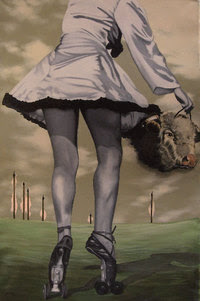
Surrealism was a powerful invention, which proved to be useful not only in painting but also in photography (above), music, film and novels. The problem with the technique is that it's usually considered to be beyond criticism. A lot of bad surrealism ( I don't mean the photo above), gets by because no one knows how to logically criticize something that's supposed to be beyond logic. I say "supposed to be," because it seems to me that the best surrealism does mean something on some level.

Take Dali's "The Persistence of Memory" (above), for example. I don't see anything having to do with memory in the picture, but I do see a world where time has been slowed down and been rendered meaningless. The dead tree, arid plain, and stagnant ocean tell us that such a world would be a bleak sort of Hell where nothing interesting or significant ever happens. It's like the Earth would be if it survived to see the energy-deprived, heat death of the universe. It's a useful metaphor when you're vegetating in a waiting room or looking back on a life of quiet desperation.

But not every kind of surrealism has meaning. The picture above is simply a collection of random images placed on a bleak, Daliesque-type plain. It heightens our awareness of how weird the world is, but not much else. The artist didn't have an idea to communicate.

Here (above) the artist is communicating, though what he's saying is open to interpretation. For me it says The dynamic world of heavy industry is present in some sense, even in a quiet and sedate room like the one above. It's a reminder that worlds can intersect, that dual realities can exist, that one world can suddenly and violently impose itself on another.

Here's (above) another one where the artist has nothing to say. He attempts to remind us that man is capable of mathematical and abstract thought, but says we don't produce anything worth hearing about. The message is anesthetizing rather than interesting. This is the kind of arid, humorless surrealism you used to see on newspaper editorial pages.

More meaningless surrealism (above). The images exist because the artist was free-associating and didn't know what else to say.

Back to meaning again. This is Dali's "Daddy Longlegs" picture (above) where the artist posits a world of absurdity. Far from being arid and stagnate, this one posits frantic but meaningless activity. It's all about futility; beautiful, marvelous futility. Once again, it's a great metaphor.

This (above) is one of the worst surrealist pictures I've ever seen. It has no meaning whatsoever. Even surrealist pictures have to have meaning.

I don't mean to say that surrealism always has to contain serious messages. Some of my favorite examples are in ads that are just plain funny, like the parody of Dali above. Dali's bleak view of the world was always deliberately undermined by his sense of humor and drama. He seems to refute his own notion of absurdity by putting us in the judge's stand where we can laugh at the meaninglessness of it all.

My favorite kind of surrealism is the kind (above) that makes fun of surrealism. Surreal commercials that sell things like peas and stockings are hilarious. They seem to say, "The world is meaningless, and you may as well commit suicide, but while you're meditating on that, how about a nice, cold glass of Schlitz beer?"

Dali's imagery is so funny that it's hard to resist parodying it, as Volkswagen did here (above). It's a very skilled picture, which isn't surprising because you have to have skill in order to joke about Dali. That's because his own pictures are so obviously the product of old master technique and funny, high-fashion sophistication. His message is a dual one: The world is both meaningless and full of meaning. Striving is ultimately meaningless but strive we must, because we are striving creatures who cannot be happy unless we are constantly trying to improve ourselves.





.jpg)






































